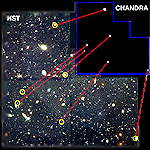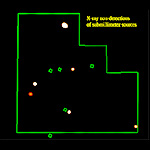May 17, 2000
CXC PR: 00-12

Hubble Deep Field North (optical),
showing X-ray
sources identified by Chandra.
Jpeg | PS |
Powerpoint and PDF
Credit: optical: NASA/HST; X-ray:
NASA/PSU
Scale: 1 arcmin on a side
Using NASA's Chandra X-ray Observatory, astronomers have made the first long-duration X-ray survey of the Hubble Deep Field North. They detected X rays from six of the galaxies in the field, and were surprised by the lack of X rays from some of the most energetic galaxies in the field.
The X-ray emitting objects discovered by the research team are a distant galaxy thought to contain a central giant black hole, three elliptically shaped galaxies, an extremely red distant galaxy, and a nearby spiral galaxy.
"We were expecting about five X-ray sources in this field,"said Professor Niel Brandt of Penn State University, University Park, and one of the leaders of the research team that conducted the survey. "However, it was very surprising to find that none of the X-ray sources lined up with any of the submillimeter sources."
The submillimeter sources are extremely luminous, dusty galaxies that produce large amounts of infrared radiation. Because they are over ten billion light years from Earth, their infrared radiation is shifted to longer, submillimeter wavelengths as it traverses the expanding universe. The primary source of the large power of the submillimeter sources is thought to be an unusually high rate of star formation, or the infall, or accretion of matter into a giant black hole in the center of the galaxy. X-ray observations provide the most direct measure of black hole accretion power. X rays, because of their high-energy, would be expected to pass through the gas and dust in these galaxies, unlike visible light.
"With Chandra we have been able to place the best X-ray constraints ever on submillimeter sources," said Ann Hornschemeier, also of Penn State, and the lead author of an upcoming Astrophysical Journal paper describing the discovery. "Our results indicate that less than 15 percent of the submillimeter sources can be luminous X-ray sources."
"That means," Brandt explains, "Either there is an enormous amount of star formation in those galaxies, or these objects contain the best-hidden black holes in the universe."

Chandra image showing X-ray
sources in Hubble Deep Field North
and positions of submillimeter-
emitting galaxies (boxes).
Jpeg | PS |
Powerpoint and PDF
Credit: NASA/PSU
Chandra's increased spatial resolution--the capability to concentrate X rays into a smaller area--also increases its sensitivity for detecting fainter X-ray sources than ever before. "Many of our sources are fainter than any source that was detected in the deepest observations by all previous X-ray observatories," Hornschemeier says. The research team used Chandra's Advanced CCD Imaging Spectrometer (ACIS) to make the unusually deep observation of the Hubble Deep Field in X-rays for about 46 hours in November 1999.
The authors of the research paper titled "X-Ray Sources in the Hubble Deep Field Detected by Chandra," are A. E. Hornschemeier, W. N. Brandt, G. P. Garmire, D. P. Schneider, P. S. Broos, L. K. Townsley, D. N. Burrows, E. D. Feigelson, and J. A. Nousek at Penn State; M. W. Bautz at the Massachusetts Institute of Technology, Cambridge, MA; R. Griffiths at Carnegie Mellon University, Pittsburgh, PA.; D. Lumb at the European Space Research and Technology Center in The Netherlands; and W. L. W. Sargent at the California Institute of Technology, Pasadena, CA. The paper will be published in the September issue of the Astrophysical Journal.
The ACIS X-ray camera was conceived and developed for NASA by Penn State and the Massachusetts Institute of Technology under the leadership of Gordon Garmire, Professor of Astronomy and Astrophysics at Penn State.
NASA's Marshall Space Flight Center in Huntsville, Alabama, manages the Chandra program. TRW, Inc., Redondo Beach, California, is the prime contractor for the spacecraft. The Smithsonian's Chandra X-ray Center controls science and flight operations from Cambridge, Massachusetts.
JPEG, TIFF, PS
and
HDFN Deep Field Handout
Constellation Ursa Major
Images associated with this release are available on the World Wide Web at
AND
http://www.astro.psu.edu/users/niel/hdf/hdf-chandra.html
MEDIA CONTACTS
Steve Roy
Marshall Space Flight Center, Huntsville, AL
Phone: 256-544-6535
Barbara Kennedy
Penn State PIO, University Park, PA.
Phone: 814-863-4682
Dr. Wallace Tucker
Chandra X-ray Observatory Center, CfA, Cambridge, MA
Phone: 617-496-7998


